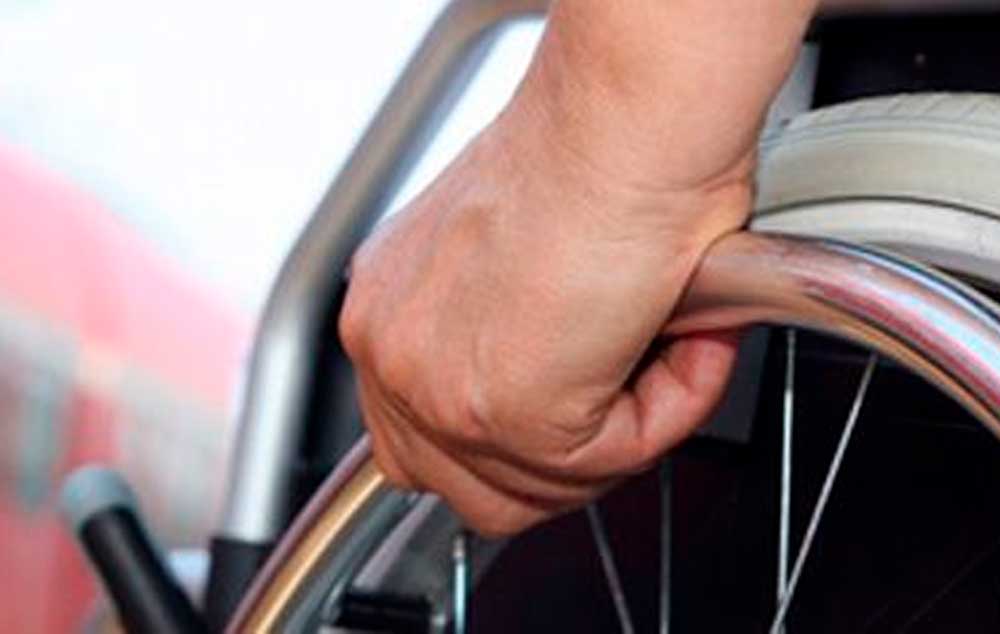
Barrier-Free Berlin. Sightseeing, relaxation and entertainment for tourists with disabilities.
Barrier-Free Berlin. Berlin, the most visited city in Germany, offers visitors with disabilities a broad range of services and options: from packages of specific information on travel to Berlin and accommodations to numerous restaurants, sights, and shopping options designated as “disabled-friendly” or “wheelchair-accessible.” Berlin’s efforts over the last years start to pay off: The city is considered to be particularly suitable for people with disabilities. In December 2012, Berlin received the Access City Award from the European Commission.
Arrival and Public Transit
The “Hauptbahnhof” main railway station in the immediate vicinity of the Government District is the largest and most modern railway junction station in Europe. Public tours are offered here twice a week. An audio guide with a variety of background information can be downloaded from the Internet. The Hauptbahnhof is architecturally impressive but also functional and modern. The building is equipped with systems to guide blind people, and its elevators have voice announcements, a service set up in close cooperation with the General Federation of Blind and Visually Impaired People in Berlin. The other main-line train stations in Berlin, such as Südkreuz and Ostbahnhof, are likewise barrier-free. Questions about travel to Berlin, help with boarding and disembarking, and other details can be answered by the mobility center of Bahn AG at +49-(0)180 551 251 2.
For those who are traveling to Berlin by air: the Berlin airports are largely barrier-free. Accessible parking spaces and restrooms are available at both Tegel and Schönefeld. Those requiring special assistance should provide notification in advance through the airline.
In addition to the Berlin travel offers in the lists of tour operators, there are many special tour operators with wheelchair-accessible buses who travel to Berlin. Their sightseeing tours are specially geared to the needs of customers with limited mobility.
In recent years, the Berlin transit authority Berliner Verkehrsbetriebe (BVG) and the S-Bahn commuter rail have equipped numerous of subway stations and commuter rail stations with elevators or ramps. At the transfer station at Alexanderplatz, one of Berlins traffic junctions, all the crossings can be managed by elevator, and there is also a system for guiding blind people.
In almost all of the bus lines, BVG buses have a ramp that can be lowered for boarding at the middle of the bus. The bus lines accessible without barriers include the popular lines 100 and 200, which travel to the most well-known sights between Bahnhof Zoo and Alexanderplatz, not unlike tour buses. On the city and transit line maps of the BVG, all the train stations, buses, and trams accessible to the disabled are labeled. It is clear from the schedules when low-floor vehicles accessible to wheelchairs are used. The BVG Internet service “travel info online barrier-free” displays barrier-free connections.
Visitors to Berlin who want a driving service that combines special wheelchair-user spaces and professional sightseeing can reserve city tours at companies like bbv Tours Berlin or Tourenbus Fahrdienst.
Berlin has more bridges than Venice, and a great many excursion boats offer a new view of the metropolis from the Spree and Oberhavel rivers or the Landwehrkanal. In the fleet of the operator Stern und Kreisschiffahrt, the “Havelqueen” is one of the vessels specially equipped for wheelchairs. It departs every day from the Greenwich Promenade in Tegel and traverses the waters of the Havel, the Spree, and the canals to Berlin Hauptbahnhof, then passes through the Government District before arriving at Schloss Bellevue. Additional routes traveled by ships accessible to the disabled, and information about the accessibility of the landing spots can be found on the Internet.
Wheelchair-accessible: from the five-star hotel to the luxury hotel in the leafy suburbs
The hotels in Berlin are considered the most modern in Europe; more than 780 establishments together offer guests around 125.400 beds. The many new buildings constructed in recent years are subject to new regulations and are therefore equipped with very wide entrances and enough turning area for wheelchairs. Among the luxurious five-star hotels, the Hotel Hilton Berlin, the legendary Hotel Adlon, and the Westin Grand each have two wheelchair-accessible rooms with wheelchair-accessible bathrooms. The Waldorf Astoria Hotel, opened in January 2013, also offers two barrier-free rooms. The congress hotel Maritim Hotel Berlin, located at the Potsdamer Platz, provides 24 rooms for people with physical limitations, five of them are wheelchair accessible. But there are also a number of wheelchair accessible buildings among the hostels and inns – for example, the Generator Hostel Berlin, Germany’s largest youth hostel with 850 beds.
At the Hotel Augustinenhof in the Mitte district, 8 out of the 63 double rooms are wheelchair accessible, and the restaurant and three conference rooms are also barrier-free. The modern hotel arcotel Velvet located in the urbane neighborhood at Oranienburger Straße offers six wheelchair-accessible double rooms with wide doors, doorways without elevated thresholds, an emergency call system, and spacious bathrooms.
Some hotels have specialized in accommodating guests with physical limitations. One of them is the Hotel Mitmensch in the leafy suburb of Karlshorst, where the staff includes people with disabilities. The objective is to provide travelers who may have special needs with pleasant service and a comfortable stay at prices below the high-end rates through such conveniences as automatic doors, motion sensors for lighting, and seven wheelchair-accessible rooms with spacious bathrooms. All of the thirteen guest rooms and the conference rooms at the hotel Haus am Niederfeld are barrier-free. The Novotel Berlin Am Tiergarten has as many as 27 rooms tailored to the needs of wheelchair users, so that large groups of these patrons can also stay there.
The Hotel Kolumbus in Berlin-Lichtenberg offers 97 wheelchair-accessible rooms. This is of particular interest to operators of special tours who are looking for appropriate hotels for group trips. The hotel is frequently the choice of accommodation for entire groups of athletes who compete at the German Track and Field Championship for Disabled People or the Special Olympics for mentally and multiply-disabled people, for example.
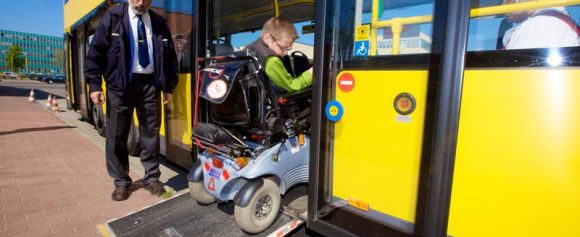 The BVG fleet of buses is completely wheelchair-accessible. Hydraulic ramps make it easy to get in and out
The BVG fleet of buses is completely wheelchair-accessible. Hydraulic ramps make it easy to get in and out
Museum Collections with Barrier-Free Entrances and Special Tours
The cultural offerings in Berlin include more than 180 museums and collections. They house artifacts ranging from archeological treasures to sugar. A growing number of museums have been renovated to accommodate wheelchairs; some are designated as wheelchair-accessible, others can be viewed by wheelchair only to a limited extent. Up-to-date information on the accessibility and the local conditions of many sights in Berlin, and of restaurants, hotels and other locations, is provided by the Mobidat database, which is maintained and updated with information for disabled Berlin visitors by the non-profit association Albatros. The database is available in German, English, Italian, Spanish, Polish, Russian and Turkish.
On Museum Island, for example, wheelchairs can be used in the Bode Museum and the Neues Museum, which houses the famous bust of nefertiti, among other exhibits. Nor are there barriers to disabled people at the Musical Instrument Museum next to the Philharmonic Hall, where visitors can not only see but hear instruments from five hundred years of music history. A very special experience awaits visitors after the 12:00 A.M. tour on Saturday: at that time, they can hear the sounds of Europe’s largest movie theater and stage organ, “The Mighty Wurlitzer.” Wheelchari accessible museums also include the Deutsches Historisches Museum, with a permanent exhibit showing more than two thousand years of German history; the Bauhaus-Archiv, which provides a comprehensive look at the work of the design and architecture school; and the Jewish Museum, with its architecturally and atmospherically impressive new building designed by Daniel Libeskind. The Jewish Museum and the Gemäldegalerie at the Kulturforum are two of the museums that provide tours in sign language for the deaf.
Another special attraction is the Museum of Natural History. Among exhibits devoted to many other prehistoric animals, it presents the world’s largest dinosaur skeleton: a Brachiosaurus with a height of more than 13 meters and a length of 15 meters. This giant was thought to have weighed almost fifty tons when alive. This can be pictured by means of the special “Juraskope” binocular, which brings the dinosaurs to life again virtually. Visitors with limited mobility reach the exhibit hall via a stairlift at the side entrance.
The “FührungsNetz” association of the non-profit group Kulturprojekte Berlin, which offers its professional service for various museums and exhibitions, also offers tours for people with disabilities which are developed according to the special needs of the customers.
The Kleisthaus building, the official workplace of the office of the federal government for the interests of disabled people, was expanded in recent years into a barrier-free event location for cultural and political activities in the Mitte district of Berlin. This is regularly the venue for performances, readings or exhibits of disabled and non-disabled artists.
Barrier-free shopping until late evening – and through the zoo via wheelchair
The international, urbane charm of Berlin is reflected in the many shopping opportunities presented to visitors to the city on the Spree. Now that stores are permitted to set their own hours from Monday to Saturday, many businesses are open until late in the evening, especially the large shopping centers and department stores which offer many different shops and a great variety of merchandise under one roof and are designed without barriers. The arcades the at Potsdamer Platz, for example, are equipped with elevators and wide, spacious passages, and the stores are open until 9:00 P.M. six days each week. The Galeria Kaufhof Berlin at Alexanderplatz stays open as late as 10:00 P.M. at the end of the week (Thursday, Friday, and Saturday) and offers elevators and restrooms for customers in wheelchairs. The elevators also have voice announcements for the floors and control elements operable by the visually impaired. The same service is provided by the largest department store on the European continent, the KaDeWe at Wittenbergplatz, which has seven floors on which visitors can stroll or roll, shop, and – in the famous gourmet department – dine). The Shoppingcenter Alexa on Alexanderplatzis open every day until 9:00 P.M. and has wide halls and elevators. In addition to the variety of shopping options, the Alexa offers other attractive leisure activities: Loxx Miniaturwelten, an extensive model train exhibit with digitally controlled trains ranging from the light-rail to the ICE and many other miniature transportation systems, as well as views of the city, has discounted admission prices for visitors in wheelchairs.
Moreover, the “neighborhood” shopping in the cozy and small “in” stores, which is so appealing to many Berlin visitors in search of original mementos and gifts, is also possible with a wheelchair. Some businesses feature the “Barrier-free Berlin” sign, and the addresses of these locations can be found online through the website. Others are registered in the Mobidat database. Within the framework of the EU project “Barrier-free shopping in Friedrichshain-Kreuzberg”, many business owners in that district have designed their stores without barriers, such as in the colorful shopping zones on Bergmannstraße or Oranienstraße.
Animal lovers who cannot easily walk can borrow a wheelchair at no cost at the Tierpark Berlin, the largest habitat zoo in Europe, and at the Berliner Zoo, where Knut, the most famous polar bear of the city, is growing up. A personal companion is likewise made available at no cost during zoo visits; several wheelchair-accessible restrooms are also on hand.
The fine art of horticulture from different traditions can be experienced at the “Gardens of the World” in the Marzahn Recreational Park. This roughly 2,000-square-meter labyrinth of evergreen yews can be explored by disabled people, as can the rest of the park grounds.
An overview of sights to see in Berlin is available at the Modellpark Berlin-Brandenburg in Wuhlheide, where more than fifty historic and architecturally notable structures have been recreated on a scale of 1:25, including the Brandenburg Gate, Sanssouci Palace, and the Pergamon Museum. The site is designed without barriers, and there are wheelchair-accessible restrooms in the park. The names of the models on exhibit can be read in Braille.
Dining without barriers
As of 2006, all new restaurants in Berlin must have a barrier-free entrance and appropriately equipped restrooms. But many of the older restaurants are wheelchair-accessible too: at Hackescher Markt, where the old and new Berlin meet in the lively urban bustle of the rear courtyards, visitors in wheelchairs are welcome in both the Oxymoron and the Restaurant Hackescher Hof, whether for morning coffee, a business lunch, or an elegant dinner. The restrooms are wheelchair-accessible, and the entrances and exits are appropriately wide.
Solid home cooking is served up at the restaurant Julchen Hoppe in the Nikolai Quarter, which features a cozy atmosphere and facilities that also accommodate disabled people. Culinary delights from a completely different region of the world, Vietnam, can be experienced in the stylishly furnished specialty restaurant Mr. Hai & Friends on Savignyplatz, which is also barrier-free. Those who prefer classic beef steaks and other barbecue specialties opt for the Midtown Grill on Potsdamer Platz.
At the Käfer, the roof garden restaurant in the Reichstag, visitors can not only enjoy delicious fare at midday and evenings but also experience the proximity to parliament and political decision-makers. Maybe Federal Interior Minister Wolfgang Schäuble, possibly Germany’s most famous wheelchair user, will also be among the guests?
In addition, the dark restaurants Nocti Vagus and the unsicht-bar Berlin are a special dining experience in Berlin. The waiters and waitresses serve the courses of the meal in utter darkness. Making do without appeal to the eyesight of visitors stimulates the other senses and simultaneously gives people who can see well an inkling of what it is like to be blind.
Service for wheelchair users: from breakdown service to sightseeing
If a problem with a wheelchair should arise while traveling, then the wheelchair breakdown service RPD Berlin provides assistance around the clock with an emergency service. Companies that rent wheelchairs and mobility aids can also provide a quick replacement in emergencies.
The locations of public, barrier-free restrooms can be found on the Internet site of the manufacturer Wall.
There are more than twenty mobility aid services in Berlin available to those who cannot travel alone. Their services include pushing wheelchairs and accompanying older and disabled people. They pick visitors up from the airport, take them to train or bus stations, facilitate transfers, and help on outings and shopping trips.
The “BerlinSpecialGuides” take people with and without disabilities on tours through the Reichstag, the Mitte district and Potsdam. The special tours deal with historical episodes from Berlin’s past and also impart a great deal of information and background on the subject of “barriers and disabilities”.
The glass cupola of the Reichstag, headquarters of the German Bundestag, is one of the crowd-pullers of the city. It can be viewed from a wheelchair, but the walkway ascends in a spiral shape. It is therefore recommended that a wheelchair user be accompanied by another person. An extra entrance allows people with disabilities immediate admission, making it unnecessary to wait in lines.
The Memorial to the Murdered Jews of Europe next to the Brandenburg Gate is the central Holocaust memorial in Germany. Designed by Peter Eisenman, the field of steles has thirteen labeled special passages that can also be easily traversed by wheelchair and have slopes of no more than eight percent. The underground information chamber that commemorates the Jewish victims of Nazism is accessible via elevator.
The memorial and documentation center in Bernauer Straße, where the German-German border once ran, commemorates the construction of the Berlin Wall and the history of the divided city. Remains of the wall can also be seen here at their original location. The center has an elevator and restrooms accessible to the disabled.
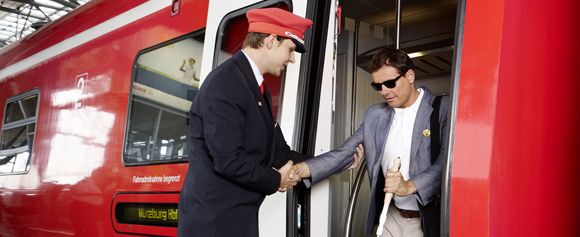 The German capital offers guests limitless mobility welcoming guests arriving at its modern Hauptbahnhof (Central Stain Station)
The German capital offers guests limitless mobility welcoming guests arriving at its modern Hauptbahnhof (Central Stain Station)
Cultural and Tourist Highlights for the Visually Impaired and Blind
The Glienicker Bridge and the Pfaueninsel? The Müggel Hills? Or maybe a tour through the park of Britzer Garden? Anyone who wants to get outdoors in the wheelchair should have the hiking guide “Barrierefrei ins Grüne” (Barrier-Free into the Outdoors). It includes a variety of Berlin routes over 2.5 kilometers in length with descriptions which are detailed enough that they can easily be followed.
Upon request, employees of the General Federation of Blind and Visually Impaired People (ABSV) accompany blind Berlin visitors to exhibits and to many interesting places and events. Museums such as the Asian Museum in Dahlem or the Gemäldegalerie occasionally offer special tours that focus on the sense of touch as a way to explore the exhibits. The dates are indicated on the events calendar at the websites of the respective museums.
With reservations in advance, the Bundestag offers visually impaired people a special service: during tours, they are allowed to enter both the visitor stand and the plenary chamber, which is closed to other groups. They can therefore try out the seats of the parliament members and literally get a feel for the German parliament. New models that can be touched also convey a sense of the dimensions and design of the Reichstag building.
The Schloss Charlottenburg, a palace built from 1695–1699 for Sophie Charlotte, wife of Friedrich III, is the largest and most beautiful structure of the Prussian rulers in Berlin. The royal rooms in the palace are accessible during tours – with a special feature for blind and visually impaired people: the entire palace grounds exist in miniature, which means that during special tours, a scale model of the palace and various other details convey a very immediate sense of the structure and its layout.
The Botanical Gardens, one of the largest and most important facilities in the world, has a three hundred year-old tradition behind it. In a special garden focusing on scent and the sense of touch, visitors can get a sensual experience of the variety of the plant world. Anyone wishing to borrow a wheelchair can do so at the entrances.
It is even possible for blind and visually impaired visitors to Berlin to follow the games at the Olympic Stadium in person. As a special service offered during home games of the national team Hertha BSC, audio commentary for the game is made available via headphones at fifty seats. Visitors must register in advance with the Hertha fan officer at +49 / (0)30 / 30 09 28 55.
At Rosenthaler Straße 39, in a rear building, is the former Blindenwerkstatt Otto Weidt, which has been converted into a small museum. Otto Weidt was himself visually impaired, and he saved the lives of many Jews in Berlin during the Second World War with his broom and brush workshop. Personal documents such as letters, poems, and photographs convey a powerful impression of the living situation of the workers, who lived in constant danger of persecution and deportation. All of the commentary on the exhibits in the museum can be read in Braille.
“AD” versions of films, which are films with an audio description heard through headphones, are shown at cinemas like the Cinemaxx Kino on Potsdamer Platz and in Delphi Palast. A real trend has started with the “radio play theater” series, which run in the summer in parks and in the winter on Fridays and Saturdays in the two planetariums of the city, appealing to both blind people and those without visual impairments.
Explore Berlin – with detailed information
Those who would like to read up in advance on the most detailed information available can find many inspirations for their trip at the website www.visitBerlin.de. Besides special tourist tips directed to visitors with various physical limitations there is also a carefully selected list of links with information for the hearing-impaired, blind people or those with vision impairments, and people with mental disabilities. In addition, with the function “limit search” in the search result overview at the online reservation of visitBerlin, users can look for and reserve a “Room and bathroom suitable for wheelchairs”. The same service is offered via telephone at +49 / (0)30 / 25 00 25.
Source: Visit Berlin
Compartilhe
Use os ícones flutuantes na borda lateral esquerda desta página
Siga-nos!
Envolva-se em nosso conteúdo, seus comentários são bem-vindos!
Artigos relacionados
Rodinha dianteira quebrada. Como lidar com um pronto socorro.
Rodinha dianteira quebrada. Imprevistos podem acontecer a qualquer hora em qualquer lugar, por isso o mais importante é saber lidar com eles.
Turismo acessível na política. Comissão do Turismo destaca a importância da acessibilidade.
Turismo acessível na política da Câmara Municipal de SP. Comissão do Turismo destaca a importância da acessibilidade para as PcD.
Teleton AACD. A pessoa com deficiência como protagonista.
Teleton AACD. A pessoa com deficiência como protagonista. Uma iniciativa internacional abraçada pelo SBT no Brasil.



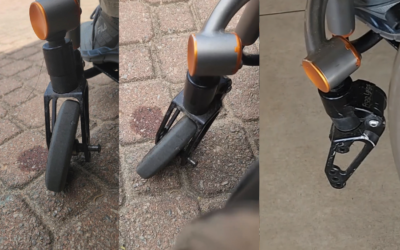
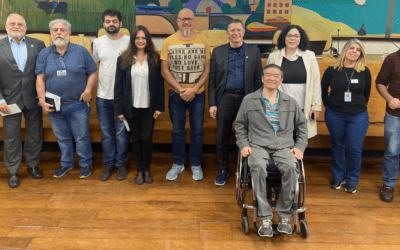
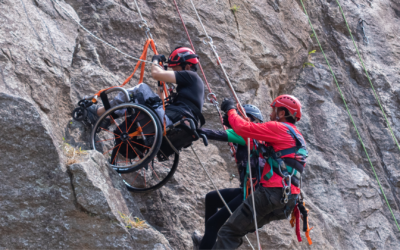
0 comentários